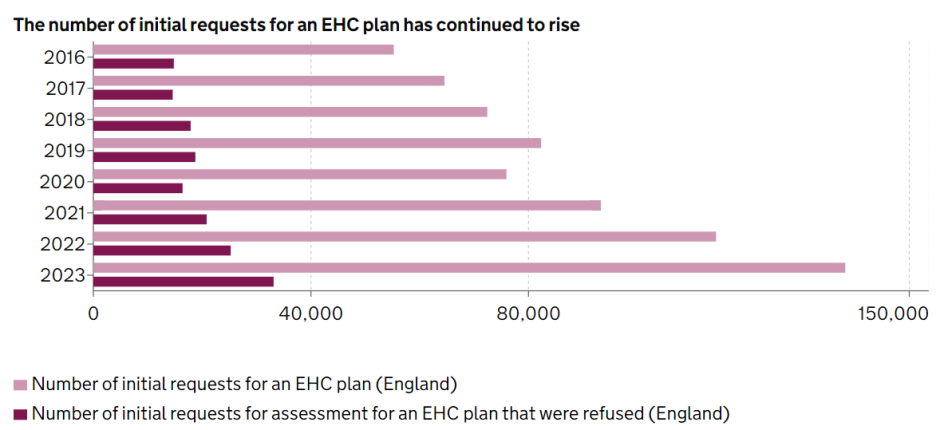The current system is simply not sustainable.
Paul Whiteman – General secretary of the school leaders union NAHT
The sharp increase in the number of children with special educational needs – particularly those with complex needs that require an education, health and care plan – is clearly unsustainable in a system that is underfunded and not fit for purpose.
Pepe Di’Iasio, General Secretary of the ASCL
There are frequent commentary articles in the media regarding climbing SEND numbers and wholly inadequate SEND provision. Parents at “breaking point,” (NI) “children missing months of school,” with parents frequently “fighting,” for specialist provision for their children and enduring process described as “overwhelming” and “demoralising” littered with examples of “long traumatic SEND battles.” All this, despite “high-needs funding” for those with complex needs rising to £10.5bn in 2024-25 (an increase of more than 60% since 2019-20.) Furthermore, I am more mindful of today, than I was yesterday, that it is not only an education that is “lost,” but “schooling,” to which I attach the importance of a social education and personal wellbeing.
Special educational needs in England
20th June 2024 – the DfE published information from the school census (state-funded schools), school level annual school census (independent schools) and general hospital school census on pupils with special educational needs (SEN).
Here is a summary outlook: a rise in the number of EHCPs, more refusals, taking longer, a failure to match rising demand with appropriate government funding, a lack of available spaces in Special schools, and local authorities having huge high needs deficits.
The number of new EHC plans made during the calendar year has increased each year since their introduction in 2014, soaring to their highest rate in 6 years, with rates increasing. The number of pupils with an education, health and care plan (EHCP) has risen from 237,000 in 2015-16 (2.8% of all pupils) to 326,000 this year (3.7% of all pupils). The number of EHC plans in place as at January 2024 increased by 58,914 (11.4%) from January 2023.
From a professional outlook, the number of pupils with EHCPs in special schools is also growing – albeit at a slower rate than mainstream numbers, but a higher rate than the previous year. That is 185,000 – up by 8%.


Special school heads say their classrooms are “bursting at the seams,” requests up, more are refused, half are still not issued by the 20-week legal deadline. The backlog of unprocessed EHC needs assessments nationally was 75% higher in January 2024 than it was in January 2023 (and it is therefore likely this has had a depressive effect on the refusal rates).
Where are the SEND category rises most prominent? A notable rise is the number of children with Social, Emotional and Mental Health (SEMH) problems (a catch all category, noting that while there’s a category for Autism Spectrum, there isn’t one for ADHD, anxiety and so on.) and girls mental health (of course the assessment delays cause issues themselves that would potential be caught here?) as highlighted by recent NHS reports and the articles hyperlinked above also.
The likelihood of a probable mental disorder increased with age with a noticeable difference in gender for the older age group (17 to 22 years); 27.2% of young women and 13.3% of young men were identified as having a probable mental disorder.
https://www.kristianstill.co.uk/wordpress/2024/04/30/the-complexities-of-mental-health-and-wellbeing-for-schools-and-colleges/
Beyond EHCPs, Tania Tirraoro over at the Special Needs Jungle, reports that “1,238,851 children are on SEN support, without an EHC Plan. That’s up by 4.7% from 2023.“
As for those rejections, the number of applications that went to mediation rose 87% to 10,300. 6,300 went to the Special Educational Needs and Disabilities (SEND) Tribunal to be resolved, a third more than in 2022. Special Needs Jungle (SNJ) offers thorough coverage of 2023 here.
The majority of children and young people with an EHC plan are male. 71.3% of children and young people with an EHC plan are male, and 28.7% are female. 68.9% of those with an EHC plan are white, 8.3% are Asian/Asian British and 5.7% are Black/African/Caribbean/Black British.
Of 32.3% that attend a special school, just 4.5% attend Special-Independent schools.
10% of children and young people with a new EHC plan which started during the 2023 calendar year who are not attending school or further education.
Funding
Meanwhile, the BBC is reporting that since 2019, the accumulated deficit in England for Special Educational Needs or Disabilities (Send) has reached £3.2bn. 38 local authorities have entered into bailout agreements or “safety valve” deals, with government.
Funding for children with Special Educational Needs and Disabilities (SEND) is in crisis. This is not new. Those of us who work with children with SEND have, for years, struggled against a system where councils simply do not have the money to meet their legal obligations. This has meant that families must fight for the education and vital support they are entitled to. It also means that children have missed out on significant parts of their education whilst waiting for support to come online, or may even go without a school place at all.
This is why it is so concerning that this long term has not been reversed, but has actually accelerated with today’s news that the shortfall has reached nearly £1billion. We urge the party [that] forms a government on 5 July to make fixing this a priority. Otherwise, the system will continue to reward families who can access support and fight hardest for the support they are entitled to, and others will be left behind.
Alex Temple, solicitor in Bindmans’ Public Law and Human Rights
Post election
There appears little consideration to this worrying situation for any of the main parties. At least, there is no mentioned of the shortfall in SEND budgets directly in any of their manifestos. The Conservatives promise more special schools, Labour promise to increase early intervention and support in mainstream schools and The Lib Dems say they would establish a national body for SEND to manage funding and give local authorities additional funding to meet the rising demand.
Next on the reading list: Special Educational Needs: Support in England (House of Commons Library). 9 February 2024



